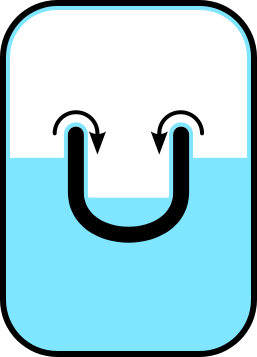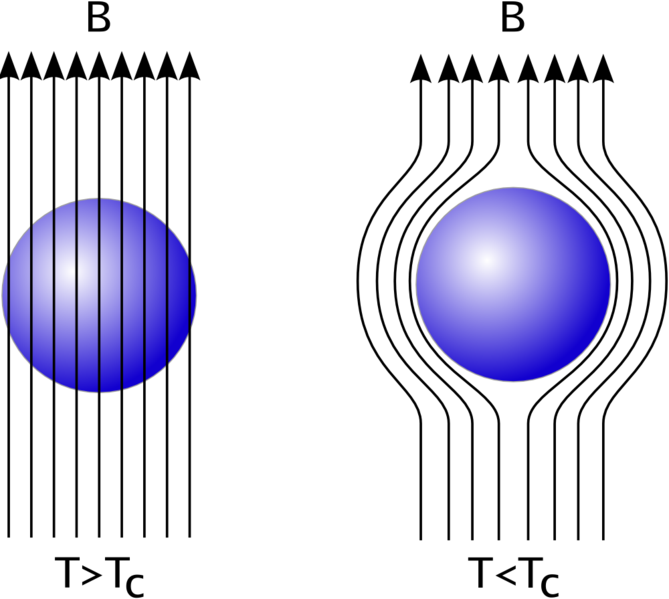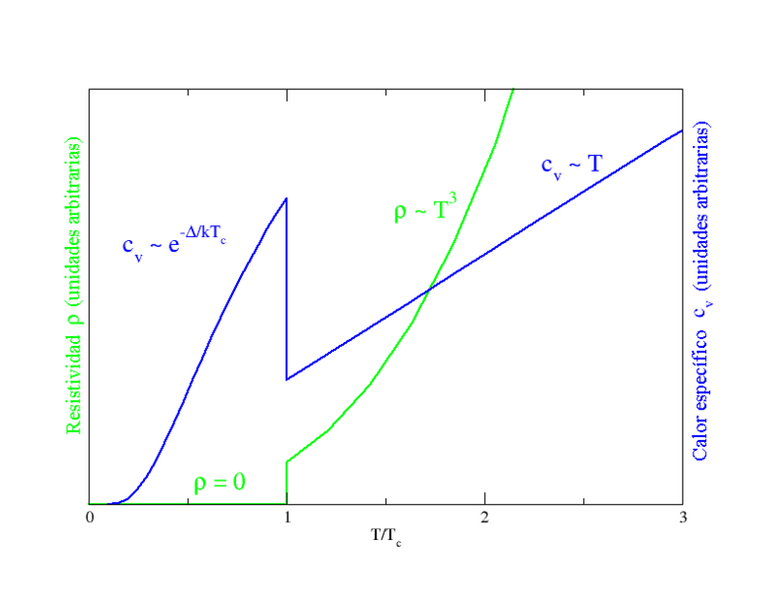
The helium 2 "flows" along the surfaces in order to find its own level. After a short period of time, the levels in two containers are equal. The movie of Rollin also covers the interior of the biggest receptacle. If this one was not sealed, the Helium II can flow and escape, source of image of mastery of Wikimedia Commons, Author Design: Aarchiba; SVG rendering: Júlio Reis
The phenomenon of the superconductivity was discovered by the physicist H.K. onnes in 1911, on having verified as it was eliminating the resistances of the mercury suddenly when the metal was cooling down below 4k (-286°C), to this temperature the thermal, electrical and magnetic properties of a lot of substances suffer drastic changes with reference to those who have to the temperature ambience. It was possible to have been proved that below certain temperatures many elements and compound chemists of such a way, that certain alloys do not show any resistance to the flow of electricity, from what are superconductors.

Heike Kamerlingh Onnes (1853-1926), source of image of mastery of Wikimedia Commons, Author: Nobel foundation
Now the phenomenon of the superfluency, it was discovered in helium 4 liquid (it is a compound of boiling of 4,2k), when it was observed that it could circulate along the thinnest capillaries and hollows from what no other liquid can do it, it is supposed that it is phenomena is due to the fact that a part of the liquid helium, due to the fluctuations, they acquire a grade zero of entropy to next temperature the absolute zero.
Some materials are conductive because any of his electrons are not tied to any atom in particular, the displacement of these electrons along the driver constitutes the electrical current. In a normal material that superconductors are not the displacement of electrons he finds certain grades of difficulty, as impurity, shock between them, dislocations, molecular vibrations, from what not all the materials have the same conductivity, in superconductor certain grade of order is established between the matter that constitutes it, in such a way that the electrons flow tidily without finding obstacle do not even make difficult, from what his resistance to the conductivity is infinite, the temperature below which a substance becomes a superdriver is named a temperature of transition.
The electrical resistividad of a metallic driver diminishes gradually as the temperature diminishes, nevertheless in the ordinary drivers, as the copper and the silver, the impurities and other shortcomings produce a value limit, Even next to absolute zero a sample of copper shows not void resistance. The resistance of a superconductor, on the other hand, lowers sudden zero when the material cools down below his critical temperature, an electrical current that superconductor flows in a spiral of cable can persist indefinitely without power supply, as the ferromagnetismo and the spectral atomic lines, the superconductivity is a phenomenon of the quantum mechanics.

Expulsion of the magnetic field, source of image of mastery of Wikimedia Commons.
As for the material superconductors, there are known hundreds of materials that have the property of turning into superconductors to low temperatures, it is that he thinks that they exist or twenty-seven chemical elements are known, which all sound metallic between which they are some common with the aluminum, the tin, the lead and the mercury are superconductors to atmospheric pressure in his form cristalográfica usual. Other onces elements that understands metals, semimetals and semiconductors, between them the uranium, the silicon and the selenium are superconductors to low temperature and discharge press, also we have other elements as the bismuth, which is not a superconductor, it is only a form of normal cristalográfica, but yes they it are in a highly untid configuration, that it is stable to low temperature.
Is necessary to take in account the following thing, although the most outstanding property of the superconductors is the absence of resistance, the true thing is that we cannot say that it should be a question of a material of infinite conductivity, since this type of material for yes only does not have thermodynamic sense. Actually a material superconductor of type the Ist is perfectly diamagnético, this does that it does not allow to penetrate in the field, which is known as effect Meissner.
The magnetic field distinguishes two types of superconductors: those of type the Ist, which do not allow by no means to penetrate a magnetic external field (which bears an energy high effort, and it implies the sudden rupture of the been superconductor if the critical temperature excels itself), and those of type the IInd, which are imperfect superconductors, in the sense in which the field really penetrates across small canalizations named whirlpool of Abrikosov, or fluxones. These two types of superconductors are really two different phases that they were predicted by Lev Davidovich Landau and Aleksey Alekséyevich Abrikósov, magnetic elements as the chromium, manganese, iron, the cobalt, and superconductors are not the nickel in any condition, nevertheless the majority of the well-known superconductors are alloys and compound chemists.
Is possible that a chemical compound is a superconductor, even in case they it are not the elements, which form it, any composed semiconductors if they are modified appropriately with impurities, nowadays the principal targets de4 the investigation in the field of the material superconductors is to be composed by temperature of transition higher and higher. The material superconductors of high temperature of transition can obtain with liquid nitrogen with a boiling point 77 k, that is an economic gas, in place that to have to use the costly helium with a boiling point 4,2k.
In the metals the specific heat is a function of the temperature. When the temperature is very low, but the metal is in the normal state (that is to say, when it is still not in been superconductor) the specific heat has the form:

As for the material superconductors, there are known hundreds of materials that have the property of turning into superconductors to low temperatures, it is that he thinks that they exist or twenty-seven chemical elements are known, which all sound metallic between which they are some common with the aluminum, the tin, the lead and the mercury are superconductors to atmospheric pressure in his form cristalográfica usual. Other onces elements that understands metals, semimetals and semiconductors, between them the uranium, the silicon and the selenium are superconductors to low temperature and discharge press, also we have other elements as the bismuth, which is not a superconductor, it is only a form of normal cristalográfica, but yes they it are in a highly untid configuration, that it is stable to low temperature.
Is necessary to take in account the following thing, although the most outstanding property of the superconductors is the absence of resistance, the true thing is that we cannot say that it should be a question of a material of infinite conductivity, since this type of material for yes only does not have thermodynamic sense. Actually a material superconductor of type the Ist is perfectly diamagnético, this does that it does not allow to penetrate in the field, which is known as effect Meissner.
The magnetic field distinguishes two types of superconductors: those of type the Ist, which do not allow by no means to penetrate a magnetic external field (which bears an energy high effort, and it implies the sudden rupture of the been superconductor if the critical temperature excels itself), and those of type the IInd, which are imperfect superconductors, in the sense in which the field really penetrates across small canalizations named whirlpool of Abrikosov, or fluxones. These two types of superconductors are really two different phases that they were predicted by Lev Davidovich Landau and Aleksey Alekséyevich Abrikósov, magnetic elements as the chromium, manganese, iron, the cobalt, and superconductors are not the nickel in any condition, nevertheless the majority of the well-known superconductors are alloys and compound chemists.
Is possible that a chemical compound is a superconductor, even in case they it are not the elements, which form it, any composed semiconductors if they are modified appropriately with impurities, nowadays the principal targets de4 the investigation in the field of the material superconductors is to be composed by temperature of transition higher and higher. The material superconductors of high temperature of transition can obtain with liquid nitrogen with a boiling point 77 k, that is an economic gas, in place that to have to use the costly helium with a boiling point 4,2k.
Where to and b it are constant that can measure oneself by means of experiments. The first term (the linear term) reflects the electrical conduction, whereas the second term (the one that changes with the bucket of the temperature) owes to itself the fonones (that is to say, the vibrations of the network).
Nevertheless, if we keep on cooling and the metal goes on to the been superconductor, this behavior changes radically: the specific heat has a discontinuity in the critical temperature, increasing sensitively, later to change of the form:

.png)
Resistividad and specific heat without magnetic field for a typical superconductor, source of image of mastery of Wikimedia Commons, Author: Spanish: Translation of Eynar from the original version in English of Alison Chaiken.
Remembering also that the superfluency, it is a physical phenomenon that limit takes place to very low temperatures, next to the absolute zero, in the one that stops all activity, a disadvantage is that almost all the elements freeze to these temperatures. But there is an exception: the helium, there exist two stable isotopes of the helium, the helium 4 (that is very common) and the helium 3 (that is rare) and beta of the tritio takes place in the breakup in nuclear reactors. Also he is in the surface of the Moon, dragged even there for the solar wind.
The incorporation of new material superconductors mostly is a miscellany of ceramics with properties superconductors, which contains lantano, itrio or other elements of the group of the ground rare, except the cerio, praseodimio, promecio and terbio, contains an alcalinotérreo we have: barium, copper and oxygen. The ceramic materials of class 1 has chemical formula of the type: La2xAxCuO4y%5, where A is an element alcalinotérreo and x is a natural number, those of class 2 are of the type: Aba2Cu3O7-x%5, where this case A is an element of the rare grounds and x is a number understood between 0,1 and 0,5.
Bibliography
statistical Physics - Parte2 - Page x for Lev Davidovich Landau, E. M. Lifshitz, Lev Petrovich Pitaevskii - 1986.
Borders of the Physics in the XXIst century - Page 108 for Octavio Miramontes, Karen Volke - 2013.
Brain and universe. Two cosmologies - Page 161 for David Jou i Mirabent - 2011.
Superconductivity Wikipedia.

Congratulations @clawfinger! You have completed the following achievement on the Steem blockchain and have been rewarded with new badge(s) :
Click here to view your Board of Honor
If you no longer want to receive notifications, reply to this comment with the word
STOP